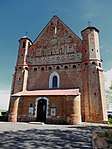Church of St. Michael, Synkavichy
The Church of St. Michael (Belarusian: Царква Святога Міхаіла) is an Eastern Orthodox church on the northern outskirts of the village of Synkavichy, Zelva District, Hrodna Province, in Belarus. It is an example of the Belarusian Gothic and one of the first fortified churches in the Grand Duchy of Lithuania along with the Church of the Nativity of the Blessed Virgin Mary in Muravanka.
| Church of Saint Michael | |
|---|---|
| Царква Святога Міхаіла | |
 | |

| |
| 53°07′23″N 25°09′26″E | |
| Location | Synkavichy, Zelva District, Grodno Region |
| Country | Belarus |
| Denomination | Eastern Orthodox |
| History | |
| Status | Parish church |
| Architecture | |
| Functional status | Active |
| Completed | The middle of the 16th century |
| Specifications | |
| Length | 17.5 |
| Width | 13 |
| Materials | Brick |
History
There is a legend that the church was built by Vytautas, Grand Duke of Lithuania, in honour of his marvellous escape from his cousin, Jogaila, when they were at war.
In reality the church was built in 16th century. The foundation could have been done by Konstanty Ostrogski, who reconstructed similar church in Vilnius in 1511 – 1522.
After the Union of Brest, the church became subordinate to the Holy See. After Polish-Lithuanian Commonwealth was partitioned the parish stayed active, but after November Uprising the church was converted into the Eastern Orthodox.
In 1880–1881, the temple was significantly reconstructed. In 1926 it was rebuilt as a Catholic church by the government of the Second Polish Republic. In 1988–1990, it was turned into the Orthodox again.
Architecture
The church is an example of the Belarusian Gothic architecture. Its internal space is divided into the three naves supported by four pillars. The plan of the building is close to a square and has three apses on the east side. The walls are one and a half meters thick.
There are four defence towers on the corners of the church. The upper part of the western towers is made in the shape of octagon with three levels of arrowslits. Two eastern towers are cylindrical and also have arrowslits in the upper part.
The pediment has a number of niches varying in depth and size.
World Heritage Status
This site was added to the UNESCO World Heritage Tentative List on January 30, 2004, in the Cultural category.[1]
Gallery
 Landscape
Landscape Front
Front Back
Back Gates
Gates_4.jpg) Interior
Interior.jpg) Old inscriptions
Old inscriptions.jpg) Architectural sketch from 1890 by Vasiliy Griaznov
Architectural sketch from 1890 by Vasiliy Griaznov
External links
| Wikimedia Commons has media related to Church of Saint Michael Archangel in Synkavičy. |